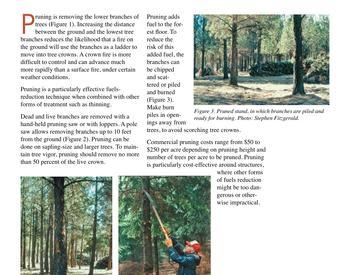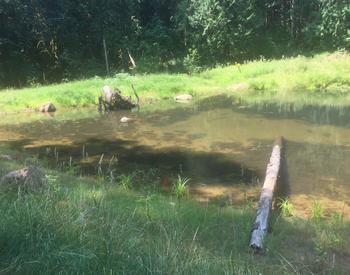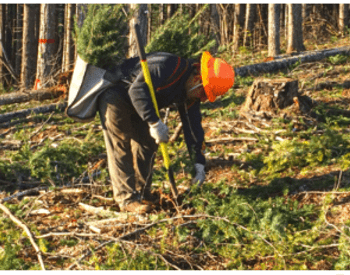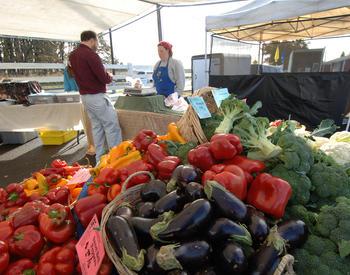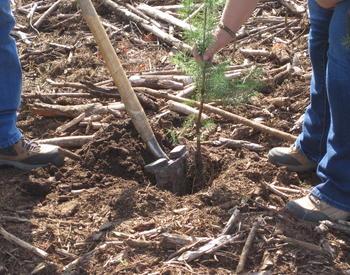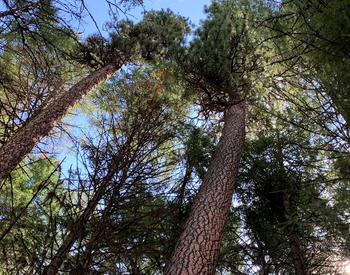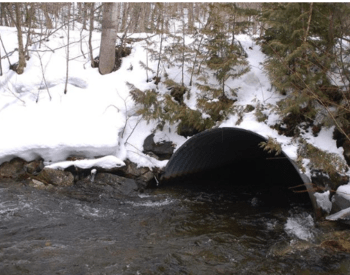Transcript
Episode 47 - Managing Forest Carbon
Lauren Grand: From the Oregon State University's Extension Service, you are listening to In the Woods with the Forestry and Natural Resources Program. This podcast brings the forest to listeners by sharing the stories and voices of forest scientists, land managers, and enthusiastic members of the public. Each episode, we will bring you research and science-based information that aims to offer some insight into what we know and are still learning about forest science and management.
Stick around to discover a new topic related to forests on each episode.
Jacob Putney: All right. Welcome back everyone to In the Woods podcast presented by the forestry and natural resource extension program at Oregon State University. I'm Jacob Putney, extension agent in Baker and Grant counties and your host for today's episode. I'm excited to be joined today by Katherine Carlisle.
Catherine is a forest carbon analyst with finite carbon in Portland, Oregon. She holds a master's in forest biometrics from Oregon State University and a bachelor's in environmental science from the University of Virginia. Catherine, thank you so much for joining us today. Could you tell us a little bit more about your background and some of the work, that you do as a forest carbon analyst?
Catherine Carlisle: So, I recently got my master's degree at Oregon State. Like you were saying, I was in the forest biometrics lab under Tomuska and Hillmerium. And so, my focus and research throughout that period was on forest carbon and the management practices, how they affect the carbon dynamics over long periods of time.
And so as far as management practices that I was focusing on, it was rotation age and silvicultural treatments, specifically thinning. Completing my research, I was able to publish a paper and I started working at Finite Carbon in July as a forest carbon analyst. What I do with finite carbon is I work with the rest of the analyst team.
On project development, maintenance and. Feasibility assessments of project areas that would make sense. To initiate a carbon project, so what a lot of this include what a lot of this. Does include is calculation of onsite carbon stocks. It includes projection of carbon stocks over long periods of time.
Includes baseline scenarios, which is how. You calculate how many offset credits. You can generate from a specific project. Another facet of the work I do. On a smaller team is greenhouse gas accounting for several big clients. And so, through that, it's another calculation of onsite carbon storage, annual changes in carbon storage.
As well as annual patterns in their greenhouse gas emissions from harvest, other treatment activities and processing of the harvestable products.
Jacob Putney: I also did my master's degree in forest biometrics, but with Doug McGuire. So, I really enjoyed that program. I really enjoyed it.
Catherine Carlisle: I thought it was super, it was really helpful.
It was invaluable in getting to where I am today. So, it definitely gave me a ton of opportunities and the experience I needed to move forward with my career. And it was exactly what I wanted to learn Upon going to grad school and it was actually the only lab who The professor I contacted so I just contacted Tomaskin I just applied to Oregon state and I just thought to myself if this works It's going to work if it's not meant to be I won't be accepted and luckily everything worked out loved my time at Oregon state Loved working With my advisor and was able to leverage my experience to get a really cool job.
Jacob Putney: It sounds like it was meant to be.
Catherine Carlisle: Yeah, definitely.
Jacob Putney: So, today's episode is intended to follow our previous episode that we did on forest carbon and forest carbon markets. So, the plan for today is to dive deeper into forest carbon and specifically carbon as a management objective and how sequestration and storage are influenced by management treatments.
So, to kick us off, Catherine, why don't we review some of the basics? Could you tell us a little bit how foresting and development and dynamics influence carbon over time?
Catherine Carlisle: So, I guess a good starting point is the how forest ecosystem sequester carbon dioxide from the atmosphere, through the process of photosynthesis.
And through that, they store that carbon within their woody biomass. Which allows for tree growth over time from this and this is what we call the live tree biomass pool from that pool carbon moves into the standing dead if mortality occurs. It can move into the dead and downward pool after that standing dead decomposes.
It also has inputs to the forest floor through the process of obviously standing dead. Snags, they fall into the ground and the logs decompose, and through that decomposition, carbon is released back into the atmosphere, or it continues to be stored within the soil carbon and forest floor pool. On the flip side of things, when harvest activities occur, that carbon stored within the live biomass will continue to be sequestered within harvested wood products, and this depends on what the end use of the wood products is.
A bit structural number that carbon is going to be stored for extended years of time. So that's going to be your saw logs and veneer. When they're used as building materials and other products, such as. And fuels that are immediately emitted biomass energy. And firewood, those are not going to have as long.
Life in products, they are, it will continue to be sequestered for a limited amount of time. And as those products are transferred into the landfill.
Jacob Putney: And how does that vary by like forest type, species mixtures and the structure of the stands or they're uneven aged or even age stands, things like that.
Catherine Carlisle: So, the carbon dynamics absolutely do vary by forest type. So, I can give you a couple of examples right off the bat and hardwood trees, they have woody biomass that is much more dense than softwood trees.
They do have more carbon per unit of volume than do the softwood trees. For example, if a conifer and a, let's say oak, they have the exact same volume, you're going to see a lot more carbon stored within that oak just because the density of the wood. On the flip side, this is region dependent. Softwood trees do have faster rates of growth than you're going to see in hardwoods.
So, they have the capability to. Take that carbon dioxide from the atmosphere and sequester it with their biomass at faster rates. There are a couple other examples I can think of right on the top of my head. So, conifer trees, especially spruce and fir, when their needles fall, that, that carbon on the forest floor takes a lot longer to decompose than you would see with fallen leaves of hardwood trees.
Moving forward, regional and forest type. They have an impact on the quantity of carbon stored within the forest soils pool, and then you can get in from a more geographic standpoint, the carbon on the forest floor is going, and dead and down wood, that in colder regions, that's going to take a lot more time to decompose than you would see in, let's say, tropical regions.
Just because of the short, if there's a frost layer, that's going to stall the decomposition process relative to if there's no, frost at any point in the year. And there's a couple other points that I wanted to touch on by varying of carbon dynamics. One is that management styles do have a big impact. So, let's say, for example, you are harvesting wood for Whether it's structural lumber or pulpwood or wood that's going to be immediately emitted.
Obviously, for the structural lumber, like I was talking about before, that's going to have a much longer total in use lifetime. So that carbon will continue to be sequestered. But if you're looking at cut wood harvested for biomass or firewood, that's going to release more carbon dioxide. Into the atmosphere, during a shorter time period.
Jacob Putney: So, let's get into some of that management stuff. So, you alluded to it during your introduction, but you published a great paper as part of your master's research on the influence of forest management on carbon. And you published, was it last year? Modeling above ground carbon dynamics under different silvicultural treatments on the McDonald Dunn Research Forest.
Catherine Carlisle: I was able to publish that in fall of 2023. I can just do a quick overview of what we were looking at and the major results that we were able to find. Specifically, we were looking at how rotation age and thinning treatments would impact the long-term carbon storage stands on the McDonnell Dunn.
And ideally, we were targeting Finding the optimal combination of rotation agent thinning treatment that would maximize the gross carbon sequestration over a 240-year period. And so how we assessed gross carbon sequestration was we sum together the carbon loss from mortality and live above ground biomass together with the wood harvested over the entire 240-year period.
So that's where we're looking at basically. Carbon SE within above ground Live biome, which was the only pool we were examining the study. So, one of the other facet facets of the project was that we were making these comparisons between management regimes by different site classes. So, what that means is different levels of productivity within forest stands.
And what that means is the more productive sites have a greater capacity to support tree growth. Then do the less productive sites, so we broke down productivity classes into 4 different site classes that. We're present on the McDonald research for us, so that's going to be 1 through 4. With 1 being the most productive category, and then 4 being the least productive category.
To make these assessments, we chose a representative stand for each of the 4 site classes. And then we projected the 240 year. carbon dynamics using FBS on each of those treatments for each of the cyclases. So now to touch on the results, what we found was that on the more productive stands, cyclase 1 and 2, carbon sequestration was optimized when you implemented 60-year rotations.
And for as productivity decreased, you wanted to lengthen those rotations. So, for cyclase 3, We found that an 80-year rotation would optimize carbon sequestration while in inside class four. We found that the 120 year was more suited just because of the slower growth rates. And so, for as far as the Silva cultural thinning treatments went, we did find that applying at least one thinning treatment always increased long-term carbon sequestration.
So why this was that? We found that within the projections. Was that when you applied a thinning treatment, it reduced the amount of understory biomass that was actually hindering the growth of the overstory. And because due to the fact that the overstory trees, Douglas fir, have a greater capacity to grow and store long term carbon.
So at least one thinning treatment did increase carbon sequestration over the 240-year period across the board. As rotation length increased, it was. beneficial to include at least two or three fitting treatments. And this is especially due to how those longer rotation ages were found to be best for the less productive stands, because those trees, what we found in the projections, was that the trees within that stand were more susceptible to being, to having their growth suppressed by the understory vegetation, especially right immediately following regeneration.
So, when you did apply those two or three thinning treatments, that's what allowed those stands to maximize their long-term sequestration.
Jacob Putney: So, it sounds like if, managing for carbon storage is your primary objective, that site productivity is a big determinant of that.
Catherine Carlisle: Oh, certainly. Like I was saying, it impacts the rotation age you want to manage with, as well as what treatments you want to apply.
Absolutely. Just based on the stand's capacity for growth, depending on the productivity class.
Jacob Putney: And I think another thing that I had read in that paper was that the, of big leaf maple had a big effect as well.
Catherine Carlisle: Oh yeah, absolutely. So that, removing that big leek maple is what kind of freed those less productive stands, it freed those conifers from growth suppression, and that is what allowed them to sequester, have the potential to sequester the most biomass.
For the more productive stands, this was also true, because those were subject to 60-year rotations in the optimal treatment, it was more beneficial to only apply one thinning treatment, just because of the time constraints. But for the less productive stands, because of, like I was saying, their grids was so susceptible to being vulnerable to competition from the under-shore biomass, that's when you would want to apply two or three.
Jacob Putney: Then you're studying the, those projections with FVS is over a 240-year timeframe. Six 40-year rotations for 60 year 380 to 120 for each rotation was the competing vegetation treated at planting for each.
Catherine Carlisle: We did simulate herbicide treatments, but without a sufficient amount of that big leaf maple being reduced from the thinning treatments, the herbicide treatments weren't as effective preventing growth suppression of the Douglas bark trees.
Jacob Putney: Did you allow for stumped sprouting?
Catherine Carlisle: Yes.
Jacob Putney: That's probably, I imagine, one contributing factor and that was with the organon. Sorry, to getting too far into the weeds on some of the growth model stuff, I really enjoy some of that stuff. That
Catherine Carlisle: was, you did use the organon bearing of FBS to do all the predictions.
Jacob Putney: So, based on the results that you found, if someone was interested specifically for managing for forest carbon, what general techniques or changes would you suggest that they make in terms of a civil cultural regime? So, rotation ages and thinning regimes, things like that. It sounds like a site productivity is the first thing you should determine.
Catherine Carlisle: Oh, absolutely. So just because of the impact on site productivity on the optimal management scenario and regime, you're going to want to choose. I would say you need to make really sure that when you are finding out the site index, just because it's so sensitive to measurement errors, you want to do everything you can to make sure you're getting realistic measurements.
and I don't know how much background information, how much background information do you want on site index?
Jacob Putney: Why don't you introduce Site Index a little bit, just so folks have an idea that aren't familiar with it.
Catherine Carlisle: Okay. So, Site Index is the height of a tree at a given reference age. In most cases, the height of the tree at 50 years of age.
So that is thought to be representative of site productivity because height is an attribute that is thought to not be as affected by. density, in other words, competition from other trees, as you would see that affecting diameter and basal area growth. site index, that's why height is selected as the attribute to, calculate site index.
Jacob Putney: On the East side Site index isn't as great of a determinant, unfortunately it can be, but we use a hundred-year site index curves for Ponderosa pine, for example. and Plant Association actually ends up being a better predictor of site productivity than site index. But for, the west side, that's definitely commonly used for sure.
Catherine Carlisle: There's several different ways to represent site productivity, and I heard of using plant associations. In some areas it can be more representative.
Jacob Putney: Plant association's a big one. A lot of the stocking guides are based off of planting, plant association and site index. The question I had about your research was, did you look at any of the tradeoffs for each of the different kind of scenarios and the different rotations on like gross and net volume production?
Catherine Carlisle: So, one of the things that I did examine was the mean annual increment of merchantable volume increase. And so obviously you can imagine. The volume is highly correlated with above ground biomass growth. So, the more volume you're producing, the naturally that corresponds to however much above ground live biomass you're sequestering.
So, because of that, it's pretty intuitive that when you're implementing these treatments that will maximize the sequestration with an above ground live biomass. That also has a positive impact on total yield.
Jacob Putney: Definitely. No, that makes sense. So, if someone was interested in managing specifically for carbon and wanted to get a step further, how would these kind of techniques fit as a potential carbon project?
Catherine Carlisle: So ultimately the more forest growth that you have within the project area, that's going to increase the total, the annual net credits that you're issued. As well as the total credits issued over the project's lifetime. And naturally with more offsets issued, that's going to increase your total revenue.
So, any treatments that you can apply or management practices in general, that you apply to increase that total forest growth, you're going to see a higher net revenue from your carbon project. So
Jacob Putney: I guess to clarify, within a carbon project, there's a set contract length, would. Varying rotation lengths conflict with that if you did want to harvest that, say 60 years with one light thinning in a high site, Douglas fir forest, for example.
Catherine Carlisle: So, there are harvest restrictions within the project area, how we restrict the amount of harvest that can be done within that project area. We start by calculating a baseline scenario and what this represents is the hundred-year average carbon stocks. That would be present on the project. If it was not enrolled and within an onset project, as long as the car, the total onsite carbon stocks did not dip below this baseline amount, then it's completely valid for a project.
Jacob Putney: So that additionality is.
Catherine Carlisle: now, yep. That's exactly what that is. And I think it's important to touch on how we calculate these baseline values, because I think there's a lot of talk in the media about how additionality is not really generated, whether there's a project developed on a piece of land that was already going to be in reserves, just whether it's an unrealistic baseline scenario where the average carbon stocks are not going to be generated.
They're not reflected and the, just basically the baseline isn't realistic. We have a lower, there would be a lower calculated value for the baseline than you would actually see. So, at our company, we put a ton of effort and research into calculating our baseline, 100-year carbon averages. And to do this, we take in the landowner information from historical management practices.
On that project area management practices in the on the rest of the property We also take a look at federal state and local regulations on management practices and what the landowner can potentially implement on the property? So, these are going to include things like amount of continuous acreages that can be clear cut the specifics of what qualifies as a certain kind of treatment, it's going to include any endangered species regulations.
And another example could be what are the restrictions on treatments or harvest within those right period zones. So, we take that information into account. we take into account the regional mill capacity because if we assert in our baseline that more wood will be harvested than can be processed by the local mills, that wouldn't make sense.
Some other things that we look at are typical yield that you would see Based on historical information and mostly our projections that we do in FDS from the current inventory data at time of initial project development, so we take all that information in when we're developing our baseline scenario, and we try we put a lot of emphasis on developing conservative baselines.
And so, what that means is We The 100-year values, that are calculated by us in our conservative baseline assessment, they are not going to undershoot what you would actually see in reality if the project wasn't involved, in an offset project.
Jacob Putney: you mentioned regional mill capacity, but just out of curiosity, do you also account for a local workforce to the amount of contractors in an area or truck drivers, things like that, because that can be a limiting factor in my area, at least, but I don't know how that might play in effect.
Catherine Carlisle: That's definitely taken into account. Just like both the land and our capacity to harvest, as well as the external factors like labor at any part in the harvesting transport or processing the harvested wood products.
Jacob Putney: Okay, on the same topic of carbon projects, so thinking about like smaller landowners that we work with a lot in extension, what are some of the barriers or challenges for enrolling in a carbon project for those kind of smaller acreages?
Catherine Carlisle: So, with smaller landowners and lower acreages, they typically can't scale to what would be viable in developing a project that we would for the larger landowners with a larger land base. This is because they are not going to see a total net revenue that makes it worthwhile when you take into account the cost of developing the project.
However, we do have another facet of the business that was recently developed called our core carbon tool. So how this does make it viable for those small landowners is that instead of doing, following the protocols that we would for the larger landowner projects, Which include total onsite verification and initial development and subsequent onsite verifications at every five years, which as you can imagine, it does include a lot of labor costs, a lot of time, because you have to get not only finite personnel, you need inventory contractors as well as a third party verification.
So that's the barriers for them to enter those smaller landowners to enter into a project. Just because the total like I was saying the total net revenue isn't going to balance out to a point Where they're going to see a considerable net revenue from their smaller land base but with our carbon with our core carbon tool how that is set apart from the Process that I was just touching on it leverages remotely sensed data together with FIA Data inventory data so that there's less You Labor involved in developing projects and therefore it does make it viable for landowners with anywhere between 40 acres and 5, 000 acres.
so, it grants more opportunities to the smaller landowners, which I think is really cool.
Jacob Putney: Yes, I think that as the kind of carbon economy continues to evolve, it seems like there's a push to, to make these more accessible for smaller landowners.
Catherine Carlisle: Absolutely.
Jacob Putney: So, what do you say would be your outlook? Do you think that in Oregon, for example, those programs will get up and running within the next few years?
Catherine Carlisle: Definitely. So, with our core team, they've mostly been focusing on the Northeast so far with a smaller portion of projects, in the Southeast, but as that program continues to develop and makes strides in. The processes that they do use to develop those projects. I think you're going to see regional expansion whether that be out west the lake states southwest I think that because it's just starting out the Regions that you can enact these smaller projects in, they’re a little limited if you will say but I think over time Over the years you're going to see that expansion to other parts of the United States.
Jacob Putney: I think we could probably cover a million more things on forest carbon, but as we're near the end here, I just want to make sure we don't miss anything.
So, do you have any parting thoughts on managing forest carbon, anything from your research or carbon projects or anything else you'd like to share?
Catherine Carlisle: So, I just wanted to touch on in general, I think the forest carbon world and the forest carbon offset. Economy is going to keep growing year to year. We've already seen explosive growth from 2012 to the present.
And one of the big reasons for this is that there are more landowners. Who are interested in developing voluntary carbon projects. And more buyers that are interested in buying those voluntary credits. And, but compared to, Previously, when the California first implemented their compliance program through the California Air and Resources Board, that was mandating the companies in California who were emitting fossil fuels, they were required to buy a certain amount of offset credits.
So that was how this whole market developed, but now we are seeing more interest in buyers who are not mandated to buy those offset credits. They're still wanting to purchase the credits and there are a couple of reasons for this. I think a lot of it is how the social changes are pivoting to where companies want to incorporate more ecological principles.
And for whether that be for internal company ethics or PR, I think that is generating a lot more business. Or the voluntary carbon and so that as that expands as well as the small landowner program, I think we're going to see a lot more action in these carbon markets and essentially, I think we're still in the very early stages of the forest carbon space and I think it's only going to grow from here.
Jacob Putney: So, the compliance market is much larger than the voluntary market currently. But do you see that changing and you think the voluntary market's really going to see some growth over the next few years?
Catherine Carlisle: Oh, absolutely. Just within our company, we are starting to develop, a ton of voluntary projects. So, our compliance projects, we maintain them, but, and we have since whether they started 10 years ago, five years ago.
So those are projects that have already been developed. With the voluntary, we've got many projects that are currently in initial development. And I think we're going to see that trend for the years to come.
Jacob Putney: I think that a little bit more flexibility with the voluntary markets will help decrease some of those barriers to entry as well.
Catherine Carlisle: Absolutely.
Jacob Putney: All right, Catherine, thank you so much for sharing your expertise with us today. Forest carbon has been a hot topic these days and the carbon economy continues to evolve, as you mentioned. Hopefully these past two episodes helped clarify these kind of complex topics. But if any questions came up while you were listening, or if you'd like to learn more, please drop us a comment or send us a message on our website.
Before we wrap up, Catherine, we'd like to do what we call our lightning round where we ask a few questions of each of our guests. So, the first question is, what is your favorite tree? So, it could be either tree species or just one tree in particular.
Catherine Carlisle: Okay. So, I have two. So back home in Virginia Beach, where I'm from, we, that is the northern best range of the Atlantic.
southern live oak tree, which is my absolute favorite tree. I'll say that. My favorite tree across the United States. They're beautiful and they're very nostalgic for me, just being from that area. As far as out West, I got to say Pacific Madrona, I think they're simple and pretty.
Jacob Putney: They're definitely super pretty.
I like their bark, the way that peels back like that. And to be honest, I don't think I've ever seen a Southern Live Oak. And I think that's the first one that we've had.
Catherine Carlisle: Just with the horizontal branches, branching and the Spanish moss. I think it's such a unique. Kind of ecosystem. And that's why when you're looking at pictures of estates from Georgia, it's just an iconic tree for the air for sure.
Jacob Putney: So, then the next question then is, so what is the most interesting thing you bring with you in the field? So that could just be when you're out in the woods, whether in your cruiser vest, things like that. Okay.
Catherine Carlisle: So, I don't know if I bring that many interesting things. I think the most unique thing that I bring out in the field is my pit viper sunglasses.
I, I usually get a lot of feedback on this.
Jacob Putney: No, I always have a hard time going to that. I was like, I don't know if it's interesting that I bring this and it always changes, too. I always bring something different depending on what I'm doing too.
Catherine Carlisle: I try to, when I go out in the field, I've never brought any really additional things besides the forager tools and water bottles.
And, snacks. The one thing I would say that does set me apart is those plastic sunglasses.
Jacob Putney: I usually just have a pocket full of fruit snacks.
Catherine Carlisle: Yum.
Jacob Putney: All right. And then lastly, is, are there any other resources that you would recommend for our listeners that they're interested in learning more about all things related to forest carbon or forest carbon projects or managing for forest carbon?
Catherine Carlisle: Absolutely. Just because of the growth of the forest carbon market and carbon space, there's papers coming out all the time. And whether that'd be technical bulletins from the forest service, publications from industry. Or actual academic papers, I think research just staying up to date with the literature that's coming out and there's new information coming out all the time, just because of the interest and significance of forest carbon in today's world.
Jacob Putney: Absolutely. We, in extension, just published an introduction to forest carbon hub, and it was challenging to keep it general enough where the information wasn't going to be out of date by the time that we finished it.
Catherine Carlisle: That's the thing is it's constantly developing. People are constantly making new findings, tweaking methodologies for the project development.
It's just, it's experiencing such growth that I think it's really important to stay updated.
Jacob Putney: No, definitely. Thank you again for being here today, Catherine. Forest carbon has been something I've been very interested in lately, and I definitely learned a lot today about the influences of management and about forest carbon projects as well.
This concludes another episode of In the Woods. Thank you all so much for listening. Don't forget to subscribe and we will see you all next time.
Lauren Grand: Thank you so much for listening. Show notes with links mentioned on each episode are available on our website. inthewoodspodcast.org. We'd love to hear from you. Visit the Tell Us What You Think tab on our website to leave us a comment, suggest a guest or topic, or ask a question that can be featured in a future episode.
And give us your feedback by filling out our survey. The In the Woods Podcast is produced by Lauren Grand. Jacob Putney, Scott Leavengood, and Stephen Fitzgerald, who are all members of the Oregon State University Forestry and Natural Resources Extension Team.
Music for In the Woods was composed by Jeffrey Hino, and graphic design was created by Christina Friehauf. We hope you enjoyed the episode and can't wait to talk to you again next time. Until then, what's in your woods?
This episode features an interview with Catherine Carlisle, a forest carbon analyst, discussing forest carbon dynamics, management practices, and carbon projects with Jacob Putney. They discuss ecosystem carbon sequestration, the influence of management practices on carbon storage, research findings on rotation age and thinning treatments, and the growth of the forest carbon market.
